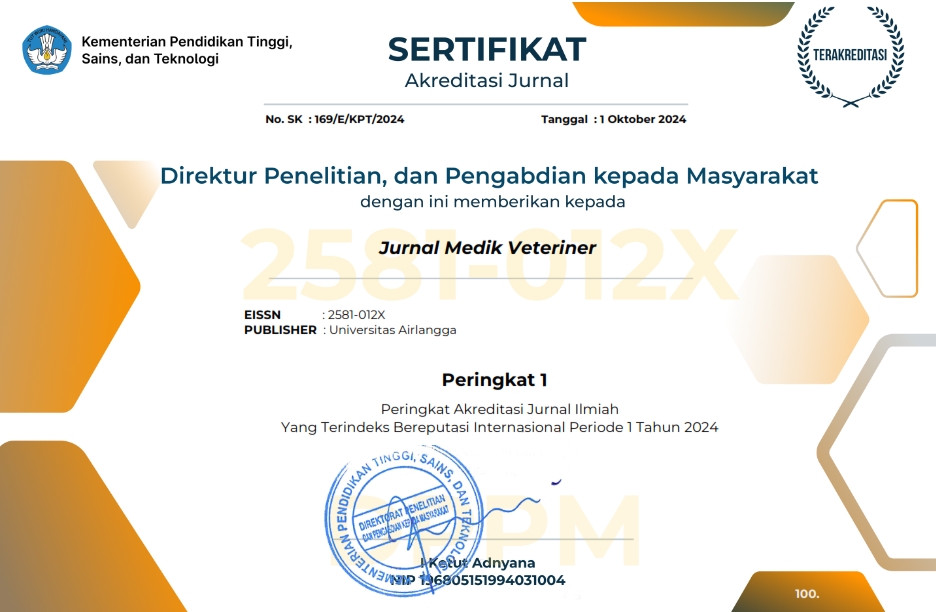Sarcoptes sp. Infection in Turtledoves (Geopelia striata) at Banyuwangi
Downloads
Arlian, L. G. (1989). Biology, host relation, and epidemiology of Sarcoptes scabiei. Annual Review of Entomologi, 34, 139-161.
Amirrudin, M. D. (2003). Ilmu penyakit kulit dan kelamin edisi I. Makassar: Fakultas Kedokteran Universitas Hasanuddin.
Ayu, S. A. (2017). Faktor-faktor yang berhubungan dengan kejadian scabies pada balita di wilayah kerja puskesmas tulang bawang baru Kecamatan Bunga mayang Kabupaten Lampung utara. Jurnal Kesehatan Holistik, 11(1), 1-4.
American Academy of Dermatology. (1938). [diakses pada tanggal 30 Oktober 2015].
Center for Disease Control Prevantion. (2010). [diakses tanggal 29 Oktober 2015].
Fenioktaviani. (2010). Analisis faktor-faktor yang berhubungan dengan penyakit scabies diwilayah kerja puskesmas cisaat Sukabumi.
Hadi, U. K., & Soviana, S. (2010). Ektoparasit: pengenalan, identifikasi dan pengendaliannya. Bogor (ID): IPB Press.
Harahap, M. (2015). Ilmu penyakit kulit, Gramedia, Jakarta.
Huang, H. P., Liang, S. L., Yang, H. L., & Chen, K. Y. (1998). Sarcoptes scabiei infestation in a cat. November 2011.
Ibadurrahmi, H., Veronica, S., & Nugrohowati, N. (2017). Faktor-faktor yang berpengaruh terhadap kejadian penyakit skabies pada santri di Pondok Pesantren Qotrun Nada Cipayung Depok Februari tahun 2016. Jurnal Profesi Medika: Jurnal Kedokteran dan Kesehatan, 10(1).
Kusuma, S. (2008). Masalah infestasi ektoparasit pada beberapa jenis burung elang di habitat eks-situ. (skripsi). Bogor: Institut Pertanian Bogor.
Kraabool, M., Gundersen, V., Fangel, L., & Olstad, K. (2015). The tavonomy, life cycle and pathology of Sarcoptes scabiei and Notoedres cati (Acarina, Sarcoptidae): A review in Fennoscandian wildlife prespecyive. Fanna Novergica, 25, 21-33.
Lawrence, G. J., Leafasia, J., Sheridan, S., Hills, J., Wate, J., Monthomery, N., Pandeya, & Purdie, D. (2004). Control of scabies, skin sores and haematuria in children in the Solomon island: Another role for ivermectin. Bull, 83(1), 34-42.
Loye, J. E., & Carrol, S. P. (1998). Ectoparasite behavior and its effects on avian nest site selection. Jurnal Entomologi, 91(2), 159-163.
Medscape. (2014). [diakses tanggal 30 Oktober 2015].
McCarthy, J. S., Kemp, D., & Currie, B. J. (2004). Scabies: more than just an irritation. Postgraduate Medical Journal, 80, 382-387.
Malik, R., Stewart, K. M., Soussa, C. A., Krockenberger, M. B., Pope, S., Ihrke, P., Beatty, J., Barrs, V. R. D., & Walton, S. (2006). Crusted scabies (Sarcoptic mange) in four cats du to Sarcoptes scabiei infestation. Journal of Feline Medicine and Surgery, 8(5), 327-339.
Oakley, A. (2013). Scabies. Retrieved May 7, 2014, from dermnet NZ. Diakses pada tanggal 5 Mei 2014.
Ronny, P. H. (2010). Scabies. Dalam: Adhi D, Mochtar H, Siti A, Editor. Ilmu penyakit kulit dan kelamin edisi keenam. Jakarta: Balai Penerbit FKUI. Hlm. 122-125.
Saim, A., & Suyanto, A. (2004). Keanekaragaman fauna parasit pada mamalia kecil dikawasan tesso-nilo, Provinsi Riau. Jurnal Ekologi Kesehatan, 3(3), 123-127.
Sutanto, I., Ismid, I. S., Sjarifuddin, P. K., & Sungkar. (2008). Parasitologi kedokteran edisi keempat. Jakarta: Fakultas kedokteran Universitas Indonesia.
Saputro, C. W. D. (2011). Ragam jenis ektoparasit burung tekukur (Streptopelia chinensis) dan burung puter (Streptopelia bitorquata) di penangkaran. (Skripsi). Fakultas kehutanan: Institut Pertanian Bogor.
Setiawan, P., & Kurniawan, B. (2016). Pengaruh personal hygiene dalam pencegahan penyakit scabies. 5(5).
Walton, S. F., & Currie, B. J. (2007). Problems in diagnosing scabies, a global disease in human and animal population. Clinical Microbiology Reviews, 20(2), 268-279.
Walton, S., Myerscough, M., & Currie, B. (2000). Studies in vitro on the relative efficacy of current acaricides for Sarcoptes scabiei var. hominis. Trans R Soc Trop Med Hyg, 94(1), 92-96.
Walton, S. F., & Bart, J. C. (2007). Problem in diagnosing scabies a global disease in human and animal population. Journal Clinical Microbiology Reviewers, 20(2), 268-79.
Wardhana, A. H., Manurung, J., & Iskandar, T. (2006). Scabies: tantangan penyakit zoonosis masa kini dan masa datang. Wartazoa, 16(1), 40-52.
Widiasih, D. A., & Budiharta, S. (2012). Epidemiologi zoonosis di Indonesia. Yogyakarta: Gajah Mada University Press.
Yunita, S., Gustian, R., & Anas, E. (2018). Faktor-faktor yang berhubungan dengan kejadian scabies di wilayah kerja puskesmas Lubuk Buaya Kota Padang Tahun 2015. Jurnal Kesehatan Andalas, 7(1), 51-58.
Authors who publish in this journal agree to the following terms:
1. The journal allows the author to hold the copyright of the article without restrictions;
2. The journal allows the author(s) to retain publishing rights without restrictions;
3. The legal formal aspect of journal publication accessibility refers to Creative Commons Attribution-NonCommercial-ShareAlike 4.0 International License (CC BY-NC-SA).






11.jpg)




















